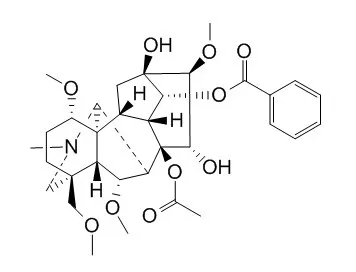| In vitro: |
| Neuropharmacology, 1990, 29(6):567-72. | | Blocking effects of hypaconitine and aconitine on nerve action potentials in phrenic nerve-diaphragm muscles of mice.[Pubmed: 2385329] | The mechanisms of neuromuscular blockade by Hypaconitine and aconitine were investigated electrophysiologically in isolated phrenic nerve-diaphragm muscles of mice.
METHODS AND RESULTS:
Hypaconitine (0.08-2 microM) and aconitine (0.3-2 microM) depressed the nerve-evoked twitch tension, without affecting the contraction evoked by stimulation of the muscle. At the concentrations of Hypaconitine (up to 5 microM) and aconitine (up to 2 microM) that depressed the nerve-evoked twitch tension, the resting membrane potential of the muscle cells was unchanged. Hypaconitine (0.1-2 microM) and aconitine (2 microM) blocked the end-plate potential (epp), without affecting the amplitude of the miniature epp (mepp). The quantal content of end-plate potentials was decreased by these agents in parallel with the decrement in amplitude. The nerve compound action potential was inhibited by Hypaconitine (5 microM) and aconitine (2-10 microM), as well as by 1 microM tetrodotoxin (TTX). When the nerve compound action potential was completely blocked by 2 microM aconitine, the muscle action potential was unaffected, although 1 microM TTX suppressed both potentials to the same degree.
CONCLUSIONS:
These results indicate the neuromuscular blockade produced by Hypaconitine and aconitine were caused by reducing the evoked quantal release. The mechanism of this effect was attributed mainly to blocking of the nerve compound action potential. |
|
| In vivo: |
| J Pharm Pharmacol. 2012 Nov;64(11):1654-8. | | Effect of hypaconitine combined with liquiritin on the expression of calmodulin and connexin43 in rat cardiac muscle in vivo.[Pubmed: 23058053] | To study the effects of Hypaconitine used alone and combined with liquiritin on calmodulin (CaM) expression and connexin43 (Cx43) phosphorylation on serine368 (Ser368), as well as to investigate the intervention of liquiritin on these Hypaconitine-induced effects.
METHODS AND RESULTS:
Adult Wistar rats were orally administered Hypaconitine (0.23, 0.69, 2.07 mg/kg per day), liquiritin (20 mg/kg per day), or Hypaconitine (2.07 mg/kg per day) plus liquiritin (20 mg/kg per day) for seven consecutive days. The mRNA expression levels of CaM and Cx43 in rat myocardial tissue were determined by real-time quantitative PCR. The protein contents of CaM and phosphorylated Cx43 (Ser368) were determined by Western blot.
The results indicated that the mRNA and protein expression levels of CaM were significantly decreased by Hypaconitine used alone and combined with liquiritin. Although CaM mRNA expression level was inhibited by liquiritin, its protein expression level was upregulated. Meanwhile, although no obvious effect on Cx43 mRNA expression was observed after the drug administration, the phosphorylation level of Cx43 (Ser368) was significantly inhibited. Furthermore, the coadministration of Hypaconitine and liquiritin significantly reduced Hypaconitine-induced inhibitory action on Cx43 (Ser368) phosphorylation.
CONCLUSIONS:
The study indicated that Hypaconitine could inhibit CaM expression and Cx43 (Ser368) phosphorylation, and liquiritin could interfere with this kind of effect by synergistically inhibiting CaM expression and by antagonizing Cx43 (Ser368) dephosphorylation induced by Hypaconitine. | | J Pharm Pharmacol. 2012 Nov;64(11):1654-8. | | Effect of hypaconitine combined with liquiritin on the expression of calmodulin and connexin43 in rat cardiac muscle in vivo.[Pubmed: 23058053 ] | To study the effects of Hypaconitine used alone and combined with liquiritin on calmodulin (CaM) expression and connexin43 (Cx43) phosphorylation on serine368 (Ser368), as well as to investigate the intervention of liquiritin on these Hypaconitine-induced effects.
METHODS AND RESULTS:
Adult Wistar rats were orally administered Hypaconitine (0.23, 0.69, 2.07 mg/kg per day), liquiritin (20 mg/kg per day), or Hypaconitine (2.07 mg/kg per day) plus liquiritin (20 mg/kg per day) for seven consecutive days. The mRNA expression levels of CaM and Cx43 in rat myocardial tissue were determined by real-time quantitative PCR. The protein contents of CaM and phosphorylated Cx43 (Ser368) were determined by Western blot.
The results indicated that the mRNA and protein expression levels of CaM were significantly decreased by Hypaconitine used alone and combined with liquiritin. Although CaM mRNA expression level was inhibited by liquiritin, its protein expression level was upregulated. Meanwhile, although no obvious effect on Cx43 mRNA expression was observed after the drug administration, the phosphorylation level of Cx43 (Ser368) was significantly inhibited. Furthermore, the coadministration of Hypaconitine and liquiritin significantly reduced Hypaconitine-induced inhibitory action on Cx43 (Ser368) phosphorylation.
CONCLUSIONS:
The study indicated that Hypaconitine could inhibit CaM expression and Cx43 (Ser368) phosphorylation, and liquiritin could interfere with this kind of effect by synergistically inhibiting CaM expression and by antagonizing Cx43 (Ser368) dephosphorylation induced by Hypaconitine. |
|






 Cell. 2018 Jan 11;172(1-2):249-261.e12. doi: 10.1016/j.cell.2017.12.019.IF=36.216(2019)
Cell. 2018 Jan 11;172(1-2):249-261.e12. doi: 10.1016/j.cell.2017.12.019.IF=36.216(2019) Cell Metab. 2020 Mar 3;31(3):534-548.e5. doi: 10.1016/j.cmet.2020.01.002.IF=22.415(2019)
Cell Metab. 2020 Mar 3;31(3):534-548.e5. doi: 10.1016/j.cmet.2020.01.002.IF=22.415(2019) Mol Cell. 2017 Nov 16;68(4):673-685.e6. doi: 10.1016/j.molcel.2017.10.022.IF=14.548(2019)
Mol Cell. 2017 Nov 16;68(4):673-685.e6. doi: 10.1016/j.molcel.2017.10.022.IF=14.548(2019)